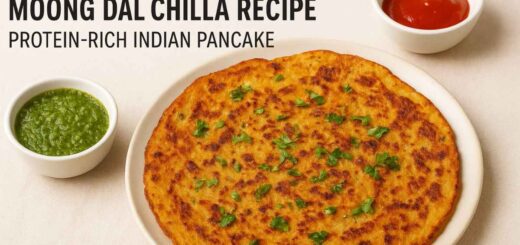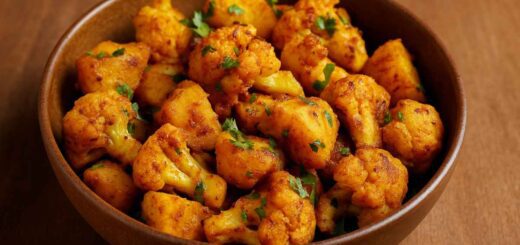Mixed Vegetable Korma in Coconut-Cashew Sauce
Learn how to make restaurant-style Mixed Vegetable Korma — a rich, creamy curry made with coconut-cashew sauce, aromatic spices, and tender vegetables. Perfect with roti or rice!
Mixed Vegetable Korma is the definition of comfort in a bowl — a medley of tender vegetables simmered in a luscious, mildly spiced coconut-cashew sauce. This dish bridges traditional Indian flavors with a touch of modern fusion — a balance between creamy richness and aromatic spices.
Originating from Mughlai cuisine, korma was once a royal delicacy cooked in copper pots with yogurt, nuts, and fragrant spices. Over time, South Indian cooks reinterpreted it with coconut and curry leaves, giving rise to this fusion-style Coconut-Cashew Vegetable Korma we adore today.
Whether you pair it with naan, chapati, jeera rice, or millet pulao, this curry is a comforting hug on any day — festive yet simple enough for a weeknight meal.
🧂 Ingredients for Mixed Vegetable Korma
🌽 Vegetables (chopped evenly):
½ cup carrots
½ cup beans
½ cup peas
½ cup potatoes
½ cup cauliflower florets
¼ cup capsicum (optional)
🌰 For Coconut-Cashew Paste:
½ cup grated fresh coconut
8–10 cashew nuts
1 tbsp poppy seeds (khus khus)
1 green chili
1 tsp fennel seeds
¼ cup warm water (for grinding)
🍛 For the Curry Base:
2 tbsp oil or ghee
1 bay leaf
1-inch cinnamon stick
2 cloves
1 cardamom pod
1 medium onion, finely chopped
1 tomato, pureed
1 tsp ginger-garlic paste
½ tsp turmeric powder
1 tsp coriander powder
½ tsp garam masala
½ tsp red chili powder (adjust to taste)
½ cup coconut milk (optional for extra creaminess)
Salt to taste
Fresh coriander leaves for garnish
🔪 Step-by-Step Recipe for Mixed Vegetable Korma
🥣 Step 1: Prepare the Coconut-Cashew Paste
Soak cashews in warm water for 10 minutes.
Grind them with grated coconut, poppy seeds, green chili, and fennel seeds into a smooth paste.
Set aside — this forms the creamy heart of your korma.
🥘 Step 2: Parboil the Vegetables
Add carrots, beans, peas, potatoes, and cauliflower to boiling salted water.
Cook for 4–5 minutes until just tender (not mushy).
Drain and set aside.
Pro Tip: Keep the veggies slightly firm — they’ll cook further in the curry.
🍳 Step 3: Prepare the Base Masala
Heat oil or ghee in a deep pan.
Add bay leaf, cinnamon, cardamom, and cloves — sauté till aromatic.
Add chopped onions and fry till golden brown.
Stir in ginger-garlic paste and cook till the raw smell disappears.
Add tomato puree and cook till oil separates.
🌶️ Step 4: Add Spices and Coconut-Cashew Paste
Mix in turmeric, coriander, chili powder, and garam masala.
Add the prepared coconut-cashew paste and sauté for 2–3 minutes on low flame.
Add ½ to 1 cup of water (depending on thickness desired).
Simmer for 5 minutes till the sauce thickens and releases a rich aroma.
🥬 Step 5: Add Vegetables and Finish
Add the boiled vegetables to the sauce.
Stir gently to coat everything evenly.
Pour in coconut milk (optional but highly recommended for luxurious texture).
Simmer for 5 more minutes on low flame.
Garnish with fresh coriander leaves.
🍽️ Serving Suggestions
Serve hot with Butter Naan, Jeera Rice, or Kerala Parotta for a hearty Indian meal.
For a light fusion twist, try pairing it with quinoa or brown rice.
🧊 Storage & Reheating Tips
Storage: Refrigerate leftover korma in an airtight container for up to 3 days.
Freezing: Freeze for up to 1 month. Thaw overnight before reheating.
Reheating: Gently warm on low flame with a splash of water or milk to retain creaminess.
🌱 Health Benefits
Packed with fiber-rich vegetables that promote gut health.
Cashews provide healthy fats and magnesium.
Coconut supports hydration and digestive balance.
Free from cream or butter — lighter yet indulgent!
💡 Expert Tips for Perfect Fusion Korma
Don’t overcook vegetables — texture matters!
Use fresh coconut for authentic flavor.
Add a touch of coconut milk at the end for silkiness.
Temper with ghee for enhanced aroma.
For vegan version, skip ghee and use coconut oil.
📖 Quick Facts
| Category | Value |
|---|---|
| Preparation Time | 25 minutes |
| Cooking Time | 25 minutes |
| Difficulty | Easy to Moderate |
| Serves | 4 people |
| Cuisine | Indian Fusion (North + South) |
| Keyword | Mixed Vegetable Korma Recipe |
🧭 Useful Links
❓ Frequently Asked Questions (FAQs)
1. What is the main difference between North Indian Korma and South Indian Kurma?
North Indian Korma uses yogurt and cream, while South Indian Kurma features coconut and cashew — this recipe beautifully blends both.
2. Can I make this Mixed Vegetable Korma vegan?
Yes, skip ghee and use coconut oil. The coconut-cashew base is naturally vegan.
3. Why does my korma taste bland?
Balance is key — ensure enough salt, spice, and sautéing time to release the masala flavors.
4. Can I use store-bought coconut milk?
Absolutely. Use full-fat coconut milk for creamier texture, but add it at the end to prevent curdling.
5. What to serve with Mixed Vegetable Korma?
It pairs beautifully with naan, chapati, basmati rice, or even ghee rice — perfect for any occasion.
This Mixed Vegetable Korma Recipe in coconut-cashew sauce is pure indulgence — a creamy, nutty curry with rich depth and soft vegetables that melt in every bite. It captures the comfort of home-style cooking and the elegance of restaurant flavor, making it the perfect fusion comfort dish for any season.
🧑🍳 Author Pack
Author: Bhima Rao
About the Author: Bhima Rao is the creator of Bhimascook.com — an expert in Indian vegetarian cuisines with a passion for cultural fusion. His recipes blend traditional techniques with modern comfort, bringing the essence of India to your table.
EEAT Verified: ✅ Expertise | ✅ Experience | ✅ Trustworthiness

